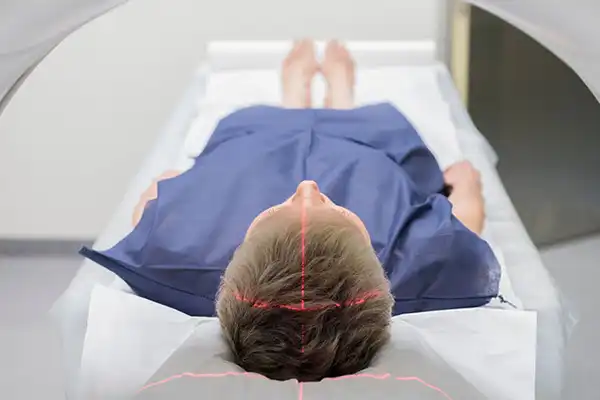

Treatments
ADVANCED PROCEDURES

Spinal Pump (Intrathecal pump)
What is a Spinal (intrathecal) pump?
The fluid filled space around your spinal cord is called the intrathecal space. Cerebrospinal fluid (CSF) flows through this area, bathing and protecting your brain and spinal cord. An intrathecal drug pump works much more efficiently than oral medication because it delivers medicine directly into the cerebrospinal fluid, bypassing the path that oral medication takes through your body. In fact, you generally need about 1/100th of the dose of medication (morphine or baclofen) with a pump than when taken orally.
What does the spinal pump look like?
The pump is a round metal device, about three and a half inches in diameter, which is surgically implanted beneath the skin of your abdomen. A small plastic tube, called a catheter, is surgically placed in the intrathecal space of the spine and is connected to the pump. A space inside the pump called the reservoir holds the medication.
How does the spinal pump work?
The pump is programmed to slowly release medication over a period of time. It can also be programmed to release different amounts of medication at different times of the day, depending on your changing needs. The pump stores the information about your prescription in its memory, and your doctor can easily review this information with the programmer. When the reservoir is empty, the doctor or nurse refills the pump by inserting a needle through your skin and into the fill port on top of the reservoir.
This therapy is completely reversible if you should ever decide to have the pump removed.
The Procedure
Once we have done the workup, including a psychological assessment, a trial stimulation is done at Atlas Pain Care, Coimbatore. This trial phase lasts for upto a week and minor adjustments are done to the spinal cord stimulator in accordance with your needs. When there are significant benefits, which is not just reduction in pain but also reduction in suffering and disability and improvement in physical activities, a permanent placement of the spinal cord stimulator is offered. This is a day care procedure in which the permanent wires are placed and a small battery is buried under the skin. The stimulation is then adjusted with a remote control to suit your needs.
Who could benefit from a spinal pump?
A pump can help lessen chronic pain caused by Failed back surgery syndrome, Cancer pain, Complex Regional Pain Syndrome, Arachnoiditis and Chronic pancreatitis.
A pump can help lessen spasticity (muscle rigidity and spasms that make movement of the arms and legs difficult) caused by Cerebral palsy, Multiple sclerosis, Stroke, Brain injury and Spinal cord injury.
What happens before surgery?
You would be scheduled for routine tests such as blood test, electrocardiogram and chest X-ray several days before surgery. If you are on any blood thinning medications, you will be advised on how and when to stop those medications. You will come fasted for 6 hours prior to surgery and will be admitted to the hospital the morning of the procedure.
What happens during surgery?
There are two parts to the procedure: 1) placement of the catheter in the intrathecal space surrounding the spinal cord, and 2) placement of the pump/reservoir in the abdomen. The operation generally takes 3 to 4 hours.
What are the risks?
Side effects for intrathecal drug pumps are minimal. As with all surgeries, complications may include infection and bleeding. The catheter could move or become blocked, or the pump could stop working (rare). Accumulation of fluid (cerebrospinal fluid leak) can occur around the pump causing a clear watery discharge from your incisions or a headache. This usually settles down, but sometimes might require a drain. Reasons for removal of the device include infection and failure to relieve pain.
Side effects from the medications can cause respiratory depression, twitching, muscle spasm, urinary retention, constipation, nausea, vomiting, dizziness, anxiety, depression, and oedema. Depending on how much medication the pump delivers, the battery will eventually need to be replaced every 5 to 7 years.
Please read our FAQ section to know more about the do's and don'ts prior to and after the procedure.

